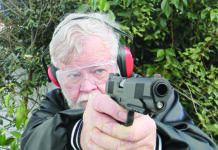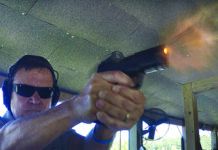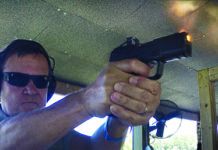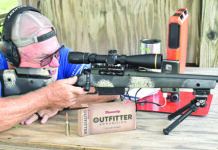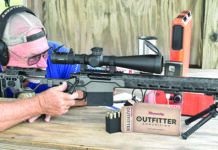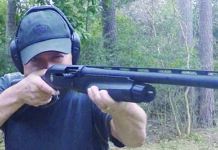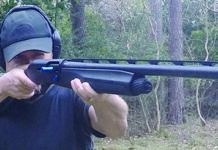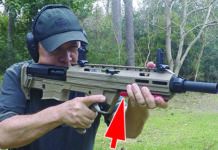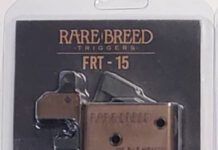Of all the clay-shooting sports, the game of trap is perhaps the least understood. But the concept is simple. Target presentation is based on the taking of a bird as if it were flushed from the ground. The name trap was taken from the original mechanism, which was as simple as releasing a live bird from a box or trap placed on the ground. The practice of using live birds then gave way to tossing glass balls as targets. (We pity the persons who were charged with cleaning up the broken glass.) According to the Krause publication, “The Gun Digest Book of Trap and Skeet Shooting,” by Christian and Sapp, the glass targets were replaced with clay “birds” some time in the 1880s. Today, the clay birds are thrown by machine. A voice-operated release system that responds to the shooter’s verbal command is the latest innovation.
Trap is great practice for the upland hunter. But it is also a fast-action quick-draw game. The powerful pattern of the 12-gauge shotgun is preferred because the targets move quickly into the distance. An important characteristic of a trap shotgun is that it delivers a pattern higher than the point of aim. This helps compensate for a target that is rising quickly, but it also helps when the target is falling.
Two features are generally relied upon to deliver a pattern higher than point of aim: A higher rib and a higher comb. A common sight picture on a trap gun is the front bead stacked above a second bead located midway down the rib. Without the presence of a mid-bead, the rib will likely appear as a ramp.
To visit a big trap match and look at the competitor’s guns can be as enthralling as attending a custom car show. But a $10K over/under is not a necessity. Nor are some of the radical modifications to the guns one might see on match day.
Gun Tests magazine evaluated a trap shotgun designed to put you into the action for much less money than expected. In looking for a suitable trap gun, they found that pump-action models were the most economical, so they looked at the Browning BPS Micro Trap 012241404, $759. The gun was a bottom-eject model, contributing to its appeal to both right- and left-handed shooters.
In preparation for the test, they poured through dozens of instructional videos old and new. The most complete explanation and demonstration they found was on a DVD entitled “Perfect Trap” ($69, from www.championvideosonline.com). Perfect Trap uses modern technology to put the viewer behind the gun and shows you what to look for before and after you call for the bird. The instructors are champion clay target shooters Ed Arrighi and Dan Carlisle. Their instruction demonstrates a wealth of knowledge not only about shooting trap but also how to coach a variety of shooters. After learning that Ed Arrighi had set up shop at American Shooting Centers in Houston (www.amshootcenters.com), they booked a few lessons before beginning the evaluation. They attested that the coaching of Ed Arrighi opened their eyes to better evaluate the shotgun and significantly raise their scores.
In trap singles competition, a single clay bird is launched from the trap house at random direction and trajectory with the shooter standing at one of five positions located 16 yards behind the point of release. The five positions are arranged in a semi-circle roughly approximating the arc between 8 o’clock and 4 o’clock. Figuring that by the time an average shooter sees the bird and fires a shot, the clay has likely traveled about 9 yards, they decided to pattern the gun from a distance of 25 yards. The gun was patterned with the supplied choke they felt would be the most popular choice for shooting a round of trap. The patterning test rounds were a popular budget-price round, a popular match-grade round, and a match-grade handload featuring AA hulls, Alliant Green Dot powder, and Remington STS primers. The budget round was the Estate Super Sport Competition Target SS12L8 load. The factory match round was Winchester AA Light Target Load AA128. The handload was constructed using a MEC 9000E. The 9000E is a progressive loader that uses an electric motor to drive the press ($899 from Trainer Hale Supply, 830-420-4530). All three rounds were 23⁄4-inch 11⁄8-ounce 23⁄4-dram equivalent charges behind No. 8 shot. For the handloads, they used magnum quality shot because the BBs are harder and less likely to deform as they speed down the barrel. The test gun was sold as a right-handed model so they patterned from the right-side shoulder. But they contested on the trap field with both right- and left-handed shooters.
In the process of acquiring a Browning Pump Shotgun, or BPS for short, GT learned that the full-size BPS Trap was temporarily out of stock. So they settled for the Micro Trap, a so-called youth model. They decided that the Micro Trap was indeed suitable because the only differences were barrel length (28 inches versus 30 inches), and a shorter length of pull. Reducing length of pull is undoubtedly the most popular modification applied to a shotgun. So, to their way of thinking, they were getting a freebie rather than a penalty. On many youth models the distance top to bottom at the butt end (from heel to toe) is reduced. This reduction in contact area can increase the sensation of felt recoil. But the buttstock on the Micro was full profile. Both Browning Trap models were chambered for 2¾-inch rounds.
The buttstock of the Micro Trap displayed a Monte Carlo profile, which served to raise the comb. The pistol grip was checkered, and the leading edge of the comb was relieved for the palm. Browning calls its semi-gloss finish “satin walnut.” The grain of the wood was visible, running horizontally from the buttpad to the receiver. The buttpad was made from hard rubber, but thanks to a generous amount of relief, it did a good job of soaking up recoil. The polished-blue receiver was engraved with floral scroll work that surrounded a scene with pheasants on one side and ducks on the other.
The safety was located atop the rear surface of the receiver and was best controlled by the thumb. The two positions were rearward for on-Safe and forward to Fire. Together with the stock that showed only the slightest cast off to the right, the top-mounted safety further increased the ambidextrous appeal of the Browning Micro Trap.
The trigger, which they measured as presenting about 6 pounds of resistance, was gold in color. The slide release was located on the left side of the receiver just rear of the trigger guard, and its operation was smooth and fault proof. The barrel was topped with a high vented rib about 0.4 inch wide that featured a small white mid bead, a light-gathering filament at the muzzle and a checkered surface to reduce glare. Beneath the barrel was a dual-action-bar slide. The satin walnut fore end was full length. The lower portion of the fore end was checkered, and about two-thirds of the upper surface was indented to further accommodate grip. The lower rear portion of the slide was relieved so that when the slide was fully to the rear the sides overlapped the receiver but did not block the ejection port.
As delivered, the Browning tubular magazine held two rounds. Remove the plug and magazine capacity reverts to four rounds. There was a shell stop located inside the ejection port that can be used to empty the magazine manually without working the slide. One interesting feature was the magazine cut-off. Located where the magazine mates with the receiver, the cut-off switch surrounded the magazine tube. With the selector pointing to the letter “R,” rounds cycled cleanly from the magazine tube to the chamber. Rotated to the letter “S,” working the slide would no longer pull rounds from the magazine. The Browning readily accepted rounds loaded by hand directly through the loading gate. This proved ideal for shooting trap singles.
Of the three supplied chokes (Modified, Improved Modified, and Full), they chose to pattern and shoot trap with the Improved Modified choke. The BPS Micro Trap patterned nearly 80% of the shot above the point of aim. Each one of the test rounds produced what they viewed as effective patterns. The Winchester AA rounds produced a dense 15-inch core pattern with an even feathering that could be described as an outer ring measuring approximately 3 inches wide. The Estate brand shot printed a 24-inch pattern that was more random beyond its 17-inch-diameter core. The handload showed about 17 inches of true density, meaning outside this diameter, the hits were not necessarily dense enough to be described as an outer ring.
At the 16-yard line they were immediately struck by how much softer the Browning shot than other guns. This could be credited to the ventilated buttpad, but they thought it was also a matter of the shorter length of pull contributing to a better fit. The BPS Micro steered easily but had enough weight so that its inertia contributed to a smooth swing and follow through. The gun felt well balanced, and it was easy to get a solid mount. The buttpad found its place, and it wasn’t difficult to level their eyes when mounting the stock. Sophisticated shooters can be very picky about small details in their setup. But they thought a lot of shooters will be satisfied with the Browning BPS Micro Trap as it is.
Gun Tests Said: The fact is that most shooters will modify the length of pull as a critical part of the fitting process. The Micro Trap will likely delete this costly step or reduce it to fine tuning by changing the buttpad. They liked the Browning Invector Plus chokes, so there is a lot of flexibility in terms of shot enhancement available for this gun. The short-stroke pump was definitely a plus, and its loading operation was flawless and precise.



